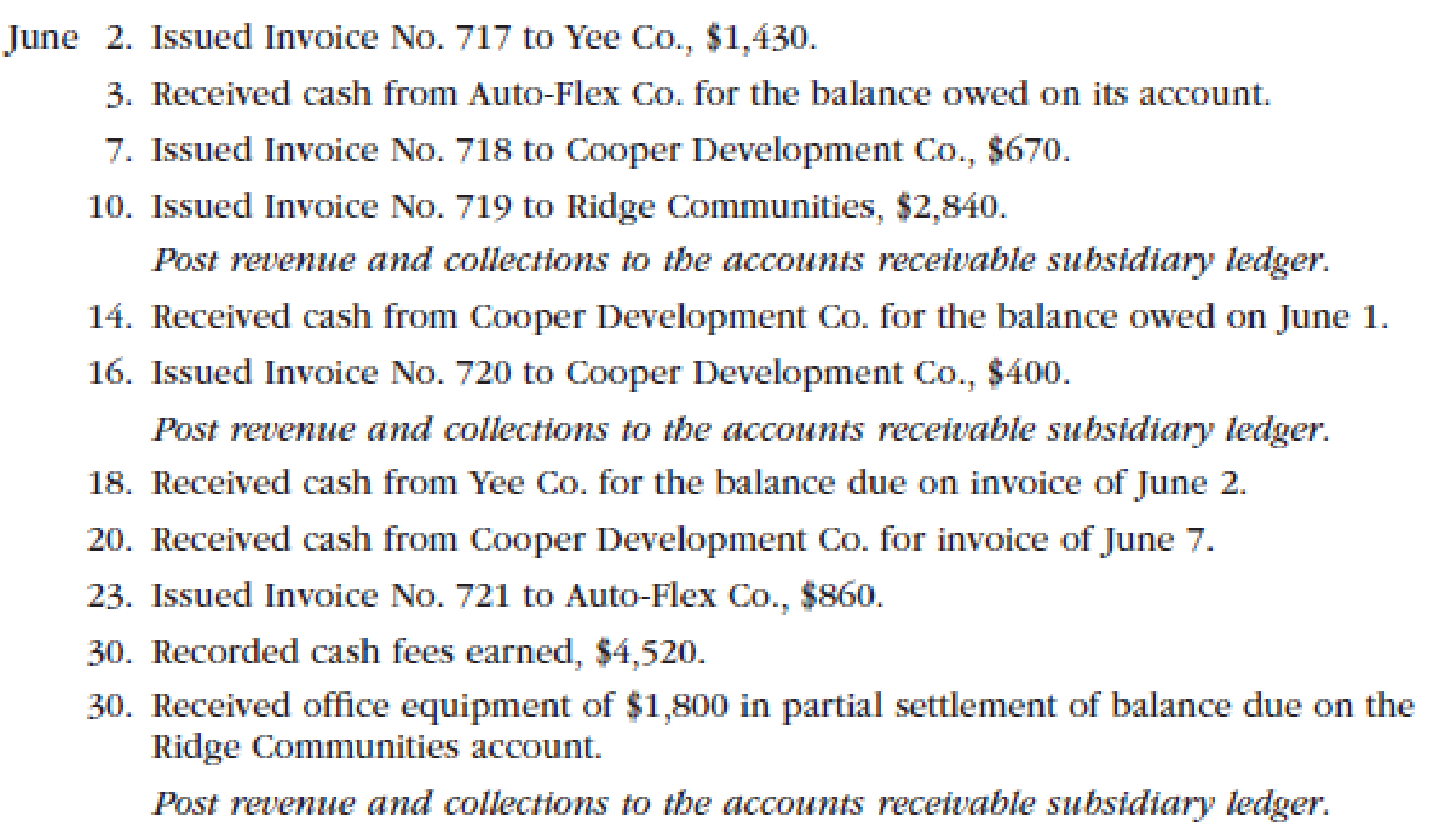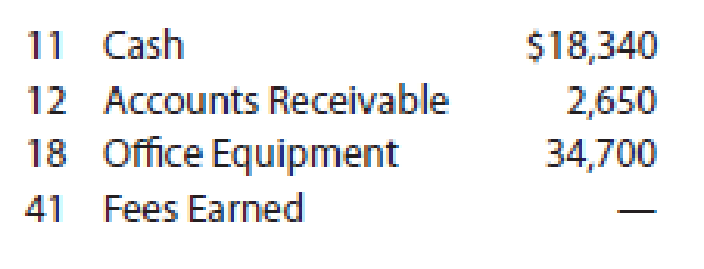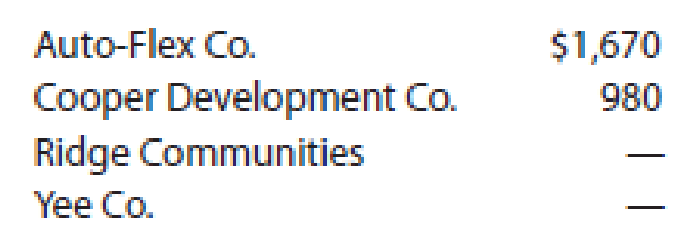
Concept explainers
Transactions related to revenue and cash receipts completed by Sterling Engineering Services during the period June 2–30, 2016, are as follows:

Instructions
- 1. Insert the following balances in the general ledger as of June 1:

- 2. Insert the following balances in the
accounts receivable subsidiary ledger as of June 1:

- 3. Prepare a single-column revenue journal (p. 40) and a cash receipts journal (p. 36). Use the following column headings for the cash receipts journal: Fees Earned Cr., Accounts Receivable Cr., and Cash Dr. The Fees Earned column is used to record cash fees. Insert a check mark (¸) in the Post. Ref. column when recording cash fees.
- 4. Using the two special journals and the two-column general journal (p. 1), journalize the transactions for June. Post to the accounts receivable subsidiary ledger, and insert the balances at the points indicated in the narrative of transactions. Determine the balance in the customer’s account before recording a cash receipt.
- 5. Total each of the columns of the special journals, and
post the individual entries and totals to the general ledger. Insert account balances after the last posting. - 6. Determine that the sum of the customer accounts agrees with the accounts receivable controlling account in the general ledger.
- 7. Why would an automated system omit postings to a control account as performed in step 5 for Accounts Receivable?
1. and 5.
Prepare general ledger for given accounts.
Explanation of Solution
General Ledger: The general journal is the journal that is used to record all adjusting and closing entries at the end of the particular accounting period. In simple, the transactions which are not recorded in the special journal that transactions are recorded in the general journal.
Accounts receivable subsidiary ledger: Account receivable subsidiary ledger is the ledger which is used to post the customer transaction in one particular ledger account. It helps the business to locate the error in the customer ledger balance. After all transactions are posted, the balances in the accounts receivable subsidiary ledger should be totaled, and compare with the balance in the general ledger of accounts receivable. If both the balance does not agree, the error has been located and corrected.
Revenue journal: Revenue journal refers to the journal that is used to record the fees earned on the account. In the revenue journal, all revenue transactions are recorded only when the business performed service to the customer on the account (credit).
Cash receipts journal: Cash receipts journal refers to the journal that is used to record all transaction which involves the cash receipts. For example, the business received cash from the customer (service performed in cash).
Prepare the general ledger for given accounts as follows:
| Account: Cash Account no. 11 | |||||||
| Date | Item | Post. Ref |
Debit ($) | Credit ($) | Balance | ||
| Debit ($) | Credit ($) | ||||||
| June | 1 | Balance | ✓ | 18,340 | |||
| 30 | CR36 | 9,270 | 27,610 | ||||
Table (1)
| Account: Accounts Receivable Account no. 12 | |||||||
| Date | Item | Post. Ref |
Debit ($) | Credit ($) | Balance | ||
| Debit ($) | Credit ($) | ||||||
| June | 1 | Balance | ✓ | 2,650 | |||
| 30 | J1 | 1,800 | 850 | ||||
| 30 | R40 | 6,200 | 7,050 | ||||
| 30 | CR36 | 4,750 | 2,300 | ||||
Table (2)
| Account: Office equipment Account no. 18 | |||||||
| Date | Item | Post. Ref |
Debit ($) | Credit ($) | Balance | ||
| Debit ($) | Credit ($) | ||||||
| June | 1 | Balance | ✓ | 34,700 | |||
| 30 | J1 | 1,800 | 36,500 | ||||
Table (3)
| Account: Fees earned Account no. 41 | |||||||
| Date | Item | Post. Ref |
Debit ($) | Credit ($) | Balance | ||
| Debit ($) | Credit ($) | ||||||
| June | 30 | Balance | R40 | 6,200 | 6,200 | ||
| 30 | CR36 | 4,520 | 10,720 | ||||
Table (4)
| Journal Page 01 | |||||
| Date | Description | Post. Ref | Debit ($) | Credit ($) | |
| June | 30 | Office equipment | 18 | 1,800 | |
| Accounts receivable-R Communities | 12/ | 1,800 | |||
| (To record office equipment purchased on account) | |||||
Table (5)
2. and 4.
Prepare accounts receivable subsidiary ledger for given customers.
Explanation of Solution
The accounts receivable subsidiary ledger for given customers are as follows:
Accounts receivable subsidiary ledger
| Name: Company Auto F | ||||||
| Date | Item | Post. Ref |
Debit ($) | Credit ($) |
Balance ($) | |
| June | 1 | Balance | ✓ | 1,670 | ||
| 3 | CR36 | 1,670 | - | |||
| 23 | R40 | 860 | 860 | |||
Table (6)
| Name: R Communities | ||||||
| Date | Item | Post. Ref |
Debit ($) | Credit ($) |
Balance ($) | |
| June | 10 | R40 | 2,840 | 2,840 | ||
| 30 | J1 | 1,800 | 1,040 | |||
Table (7)
| Name: Company CD | ||||||
| Date | Item | Post. Ref |
Debit ($) | Credit ($) |
Balance ($) | |
| June | 1 | Balance | ✓ | 980 | ||
| 7 | R40 | 670 | 1,650 | |||
| 14 | CR36 | 980 | 670 | |||
| 16 | R40 | 400 | 1,070 | |||
| 20 | CR36 | 670 | 400 | |||
Table (8)
| Name: Company Y | ||||||
| Date | Item | Post. Ref |
Debit ($) | Credit ($) |
Balance ($) | |
| June | 2 | R40 | 1,430 | 1,430 | ||
| 18 | CR36 | 1,430 | - | |||
Table (9)
3.
Prepare single column revenue journal and cash receipt journal.
Explanation of Solution
Revenue journal
Revenue journal of S Engineering services in the month of June 2016 is as follows:
Revenue journal
Page 40
| Date | Invoice No. | Account debited | Post Ref. |
Account receivable Dr. Fees earned Cr. ($) | |
| June | 2 | 717 | Company Y | ✓ | 1,430 |
| 7 | 718 | Company CD | ✓ | 670 | |
| 10 | 719 | R Communities | ✓ | 2,840 | |
| 16 | 720 | Company CD | ✓ | 400 | |
| 23 | 721 | Company Auto F | ✓ | 860 | |
| 30 | $6,200 | ||||
| (12) (41) | |||||
Table (10)
Cash receipt journal
Cash receipt journal of S Engineering services in the month of June 2016 is as follows:
Cash receipt journal
Page 36
| Date | Account Credited | Post Ref. | Fees earned Cr. | Accounts receivable Cr. | Cash Dr. | |
| June | 3 | Company Auto F | ✓ | 1,670 | 1,670 | |
| 14 | Company CD | ✓ | 980 | 980 | ||
| 28 | Company Y | ✓ | 1,430 | 1,430 | ||
| 20 | Company CD | ✓ | 670 | 670 | ||
| 30 | Fees earned | 4,520 | 4,520 | |||
| 30 | 4,520 | 4,750 | 9,270 | |||
| (41) | (12) | (11) | ||||
Table (11)
6.
Prepare the accounts receivable customers balance, and verify that the total agrees with the ending balance of accounts receivable control account.
Explanation of Solution
Accounts receivable customer balance
Accounts receivable customers balance is as follows:
| S Engineering services | |
| Accounts receivable customers balances | |
| June 30, 2016 | |
| Amount ($) | |
| Company Auto F | 860 |
| R Communities | 1,040 |
| Company CD | 400 |
| Total accounts receivable | 2,300 |
Table (12)
Accounts receivable controlling account
Ending balance of accounts receivable controlling account is as follows:
| S Engineering services | |
| Accounts receivable (Controlling account) | |
| June 30, 2016 | |
| Amount ($) | |
| Opening balance on June 1 | 2,650 |
| Add: | |
| Total debits (from revenue journal) | 6,200 |
| 8,850 | |
| Less: | |
| Total credits (from cash receipts journal and journal) (1) | (6,550) |
| Total accounts receivable | 2,300 |
Table (13)
Working note: Calculate the total credits in the accounts receivable
In this case, accounts receivable subsidiary ledger is used to identify and locate the error by way of cross-checking the customer balance and accounts receivable controlling account. From the above calculation, we can understand that both balances of accounts receivable are agreed, hence there is no error in the recording and posing of transactions.
7.
Discuss reason for an automated system omits to post a controlling accounting system.
Explanation of Solution
At the time of the original transactions are entered, the individual sales transactions are posted automatically in the computer system. So, there is no need to post the summary totals to the general ledger accounts.
Want to see more full solutions like this?
Chapter 5 Solutions
Financial Accounting
 Financial AccountingAccountingISBN:9781305088436Author:Carl Warren, Jim Reeve, Jonathan DuchacPublisher:Cengage Learning
Financial AccountingAccountingISBN:9781305088436Author:Carl Warren, Jim Reeve, Jonathan DuchacPublisher:Cengage Learning Financial AccountingAccountingISBN:9781337272124Author:Carl Warren, James M. Reeve, Jonathan DuchacPublisher:Cengage LearningPrinciples of Accounting Volume 1AccountingISBN:9781947172685Author:OpenStaxPublisher:OpenStax College
Financial AccountingAccountingISBN:9781337272124Author:Carl Warren, James M. Reeve, Jonathan DuchacPublisher:Cengage LearningPrinciples of Accounting Volume 1AccountingISBN:9781947172685Author:OpenStaxPublisher:OpenStax College College Accounting, Chapters 1-27AccountingISBN:9781337794756Author:HEINTZ, James A.Publisher:Cengage Learning,
College Accounting, Chapters 1-27AccountingISBN:9781337794756Author:HEINTZ, James A.Publisher:Cengage Learning, College Accounting (Book Only): A Career ApproachAccountingISBN:9781337280570Author:Scott, Cathy J.Publisher:South-Western College PubCentury 21 Accounting Multicolumn JournalAccountingISBN:9781337679503Author:GilbertsonPublisher:Cengage
College Accounting (Book Only): A Career ApproachAccountingISBN:9781337280570Author:Scott, Cathy J.Publisher:South-Western College PubCentury 21 Accounting Multicolumn JournalAccountingISBN:9781337679503Author:GilbertsonPublisher:Cengage





